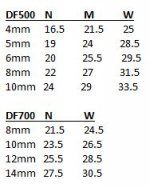Mini Me
Member
Conventional Mortise joints often get pinned or draw bored, Has anyone here done that with a Domino joint? A domino joint could be draw bored if the Domino was first glued into one mortise, pinned and glued then allowed to dry for a short time, a bit of mucking around and certainly long winded but it would increase the strength factor multiple times as would simply pinning it with a dowel.
I have as I stated earlier in this thread always seen the Domino as an alignment tool and I don't glue Dominos when using it that way but now I am beginning to see it as a bit of a hybrid when it is essential for high mechanical strength though I am yet to try it. By using the Domino to create the required width dimension of the mortise(s) using multiple cuts and the maximum depth the mortise would then be used as a template to make it deeper using a chisel in a few minutes and a loose tenon made to suit the mortise(s). The problem I see with using stock Dominos is that they don't utilise all the possible area that a conventional tenon does or can. Glue strength can never surpass mechanical strength and the loose tenon system that the Domino makes often falls short of the maximum glue area possible, a hybrid approach will overcome that issue but it would only be practical on bigger M&Ts.
An interesting question might be, why did you buy your Domino and how did you intend to use it, as a loose tenon joint maker or an alignment tool?
I have as I stated earlier in this thread always seen the Domino as an alignment tool and I don't glue Dominos when using it that way but now I am beginning to see it as a bit of a hybrid when it is essential for high mechanical strength though I am yet to try it. By using the Domino to create the required width dimension of the mortise(s) using multiple cuts and the maximum depth the mortise would then be used as a template to make it deeper using a chisel in a few minutes and a loose tenon made to suit the mortise(s). The problem I see with using stock Dominos is that they don't utilise all the possible area that a conventional tenon does or can. Glue strength can never surpass mechanical strength and the loose tenon system that the Domino makes often falls short of the maximum glue area possible, a hybrid approach will overcome that issue but it would only be practical on bigger M&Ts.
An interesting question might be, why did you buy your Domino and how did you intend to use it, as a loose tenon joint maker or an alignment tool?


